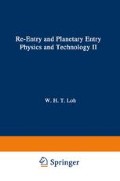Abstract
The use of planetary atmospheres for planetocentric maneuvers offers itself in the case of the planets Venus, Earth and Mars. In all three cases, the atmospheres are comparatively fluffy and thin, if compared to atmospheres of the jovian planets, and the entry velocities are usually within the range of technical feasibility. The highest entry velocities are encountered upon return from Mars along a mono-elliptic transfer orbit. Maximum velocities are in the range of 70, 000 to 75, 000 ft/sec. It is possible, however, to reduce the speed at least as far down as 50, 000 to 60, 000 ft/sec, either by a properly arranged mission profile or by a braking maneuver or by Venus fly-by on return. The braking maneuver is most economically applied at perihelion transit rather than at Earth approach. If the velocity is reduced to the level of about 60, 000 ft/sec by mission profile adjustment, direct atmospheric entry along an unretarded approach hyperbola, is technically, as well as possibly space medically, the most difficult case of atmospheric braking; but also the most rewarding case in terms of effect on the reduction in orbital departure weight of the interplanetary vehicle.
Access this chapter
Tax calculation will be finalised at checkout
Purchases are for personal use only
Preview
Unable to display preview. Download preview PDF.
References
Jet Propulsion Laboratory: Mariner, Mission to Venus, McGraw-Hill Book Co., New York, 1963, p. 105–106.
de Vaucouleurs, G.: Proceedings of Lunar and Planetary Exploration Colloquium, II: 1, Sept. 1959, p. 42.
Levine, P.: Entry of Space Vehicles into Planetary Atmospheres, Part I: Ballistic Entry, Rep. AVCO-RAD-TM-62–20, AVCO Corp., April 1962.
Hidalgo R. W. Detra: Generalized Heat Transfer Formulae and Graphs, AVCO Everett Rep. RR 72, AVCO Corp., March 1960.
Anon: Heat Shield Materials Property Handbook, AVCO/RAD Rep. No. 61–1951 (Confidential).
Author information
Authors and Affiliations
Editor information
Editors and Affiliations
Rights and permissions
Copyright information
© 1968 Springer Science+Business Media New York
About this chapter
Cite this chapter
Ehricke, K.A. (1968). Atmospheric Braking Entry and Associated Technologies. In: Loh, W.H.T. (eds) Re-entry and Planetary Entry Physics and Technology. Applied Physics and Engineering, vol 3. Springer, Berlin, Heidelberg. https://doi.org/10.1007/978-3-642-50082-4_4
Download citation
DOI: https://doi.org/10.1007/978-3-642-50082-4_4
Publisher Name: Springer, Berlin, Heidelberg
Print ISBN: 978-3-642-50084-8
Online ISBN: 978-3-642-50082-4
eBook Packages: Springer Book Archive

